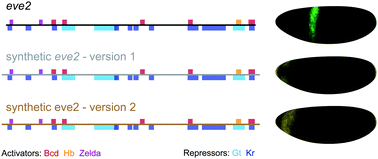The appeasement of Doug: a synthetic approach to enhancer biology†
Abstract
Genetic approaches have been instrumental in dissecting developmental enhancers by characterizing their transcription factor binding sites. Though some enhancers have been well-studied in this regard, we cannot currently build developmental enhancers from scratch. Reconstitution experiments can provide important complementary tests of our understanding of enhancer function, but these experiments are exceedingly rare in the literature, possibly due to the difficulty of publishing negative results. In this perspective, we argue that the time is right for a synthetic approach to enhancer biology. Focusing primarily on Drosophila enhancers as examples, we review classic and modern methods for dissecting enhancer function as well as computational tools for enhancer design. We include our own negative results from attempts to reconstitute the stripe 2 enhancer from the even-skipped locus and discuss possible ways forward. We believe that with a communal effort in open data sharing, we can make substantial progress toward a complete understanding of enhancer function.

- This article is part of the themed collections: Recent Open Access Articles and Biological Insights from Synthetic Biology

 Please wait while we load your content...
Please wait while we load your content...